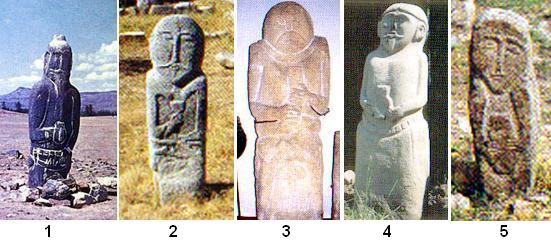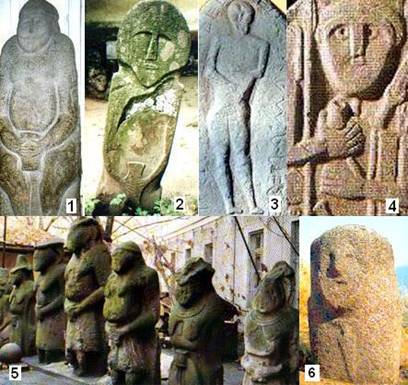|
The
stone statues in human form were highly respected by the
Turkic tribes. They were erected on top of kurgans and were
representations of the shamanic belief that an offering to the
gods was necessary. It has already been mentioned in Chapter
24 Horses for eternity
that many horses were sacrificed and buried next to the burial
chamber of a leader. Similarly, statues above the ground were
reminders to the remaining people that an offering to the soul
of the dead person or to the deity would be appropriate. This
belief had its origin in the cult of ancestor worshiping.
Archeological studies of kurgans reveal that food and drink
were left within the burial chamber, indicating that offerings
to the gods or ancestors were made before the grave was
closed.
Guillaume de Rubrouck
(1215 1295), a Franciscan priest traveling to Central Asia
for converting people to Christianity informs the following
about the burial habits of the Asiatic people
(1):
They
put into the grave some kimiz (fermented mare milk) to drink
and some meat to eat
This habit is a clear indication that offerings in the form of
food and drink were an important tradition among the ancient
Turkic societies. The human statues holding cups or containers
were therefore reminding the passer-by that an offering,
physical or spiritual, would be appropriate to the soul of the
person buried under that location. The cup or container held
close to the body was therefore a symbolic request for an
offering. Some examples are shown in the pictures below.

1.
Stone statue
standing above a burial site in Central Asia.
2.
A statue presently standing in the garden of the Bishkek
museum, Kyrgyzstan.
3.
Scythian statue holding a cylindrical vessel from Kiev,
Ukraine.
4.
Statue from the Autonomous Republic of Tuva, Russia.
5.
From the city of Taraz - Jambul Oblast of Kazakhstan
(2).
All of them
have a similar appearance and are obviously the work of a
common culture. We find similar statues in remote places
wherever the Turkic tribes migrated. Below we can see the
similarity among some exemplars from different and seemingly
unrelated cultures.

1.
Presently in
the museum of Novocherkassk, Rostov Oblast, Russia.
Novocherkassk
was
the capital of the Don Cossacks.
2.
Statue from Sarkel, the ancient capital of the Khazars.
3.
A wall relief from the Osk culture, Italy (see Chapter 8,
The Double-Edged Ax).
4.
A warrior holding a drinking vessel, from Hakkari, Turkey (see
Chapter 18,Towards Sumer and
Elam).
5.
Female statues holding cups from the Odessa Archeological
Museum, Ukraine.
6.
A statue from Corsica, France. The statue is several thousand
years old and the details are no more recognizable.
From the
picture 5 above we see that statues were erected not only for
male leaders, but also for important females. Most probably,
these were shaman women respected by their society. Even today
some Turkic tribes still hold them sacred and call them tashnine
(stone grandmother) and tashbaba
(stone father) (3).
The fact that these statues are
requesting some offering is attested by a wandering minstrel
whose name is Nizami.
He tells the following (4):
Stone statues
were erected on the steppes of the Kipchaks as talismans. All
of these talismans are still standing there. Whenever a
Kipchak comes closer to one of them, he worships him and puts
an arrow in his quiver. If it is a shepherd who comes close to
him, he sacrifices a sheep for him.
Wilhelm Radloff (1837 1918) quotes in his book entitled Aus
Siberien
(5):
The female
statue named as Kurtuyak Tash is made of gray sandstone and
erected crookedly. The pinch of hair dropping from its
backhead is hardly seen since it is eroded. Today women of the
Kamliks and the Kumans wear the same dresses. The by-passing
Tatars living in the Is-Beltir area pay much respect to her.
Everybody turns three tours around her and offer some of their
food.
People knew
that the food they offered was eaten by birds and foxes, but
their offering was for paying respect to her saintly memory. |